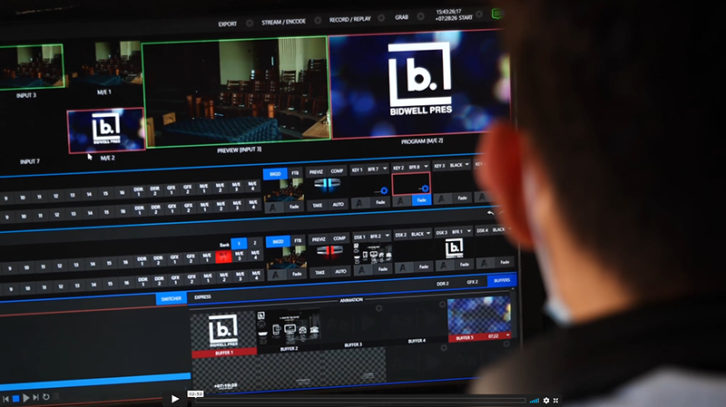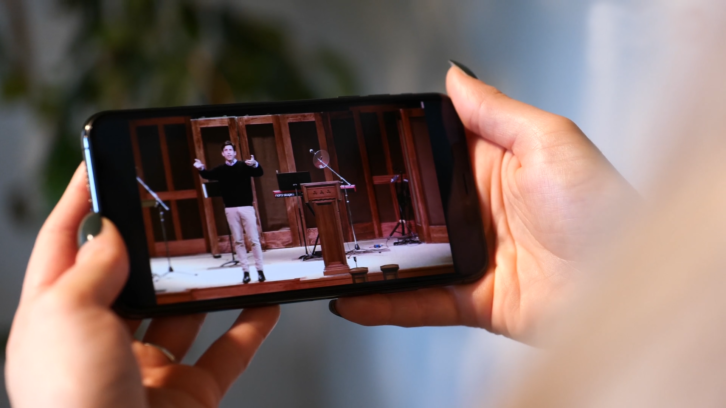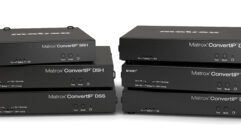

The ability to livestream services has proven to be a solid solution – and has proven to be more than just a temporary fix. Remote service offerings – be they for a primary service or in smaller group settings – have long-term value in reaching the congregation, and potential congregation, in more locations and at more times of the week.
The last 18 months have shown that one-way broadcasting is only part of today’s worship and community experience. We are now comfortably in a world where remote communication is the standard and incorporating both two-way communication and remote production capabilities is a necessity for houses of worship regardless of size.
As worship leadership increasingly see the benefits of such offerings, video experts are being asked, “what are my first steps to get started with interactive video?” The answers to this question are unique for every location, of course, which means the sound and video contractor has a critical role to play! That said, there is a template playbook for integrating live video offerings in houses of worship.
AV-over-IP
The first point of order is to look at the infrastructure. The increasing adoption of AV-over-IP among manufacturers across all product lines means utilizing a network-based protocol for audio, video, and control makes a system both interoperable and future-proof. Point-to-point connections like HDMI and SDI will limit any production to a local facility. A higher level of flexibility is required. For example, a minister that wants to address the congregation in the middle of the week, but also needs to do so from their home, must first overcome the hurdle of connecting their local camera to the production system.
Additionally, with social distancing a concern, the facility itself evolves to make use of spaces in a more dynamic fashion. Moving to an IP infrastructure allows for flexibility where audio and video signals can originate and terminate regardless if they are in or out of the facility. We are no longer bound by the constraints of deterministic signal paths. Even better, those that produce and support AV are likewise not bound by having to sit next the production equipment.
The protocols that allow for this type of flexibility come in many flavors (full disclosure, the NDI protocol providing AV-over-IP was developed by NewTek but remains free-to-use for customers). Many get distracted by which protocol is the best or what is the common standard, but the reality is that IP is the standard and it is important to use the protocol best suited for the job at hand. What is most crucial is that you choose protocols that are affordable, interoperable, and scalable in the long term.
Going back to our example of the minister delivering the mid-week message – the use of a virtual meeting room application (VMR) like Zoom™ or Microsoft Teams™ would allow for remote connection between participants. The VMR could then be connected using NDI® to the live production system at the church facility where the worship team delivers a live song as part of the service. Further, the production equipment could be operated either locally or remotely with the production team communicating in real-time. All this is possible because of networks and IP.
Fortunately, it’s not all or nothing. All big name PTZ camera manufacturers offer product lines with an IP protocol natively implemented. And for those that already have an investment in HDMI or SDI cameras, conversion devices that translated SDI into a protocol like NDI enable a hybrid approach while lowering the barrier to entry. More on that later.
It may sound obvious, but a strong connection to the Internet is a vital component as well. Having a solid link both up to and down from the Internet allows confident connection for those creating, producing, and viewing the video streams. Where the physical meeting room was the central point before, the Internet connection is now the nexus for a community that moves seamlessly between physical and digital worlds. By making the right choice at this juncture, you set systems for long-term success no matter what the future brings.
Live Production Systems

The heart of live video in a worship space is the live production system – yet it is often an element looked over as it’s considered too expensive or superfluous to the core needs. In reality, a live production system can provide many elegant, streamlined, and powerful offerings in one product. Further, the cost of these technologies has been truly democratized – making them accessible for creators of all types. In turn, they make the production process far less cumbersome and daunting on the staff and volunteers operating a live video stream. Live production systems act as a hub for incoming video, provide the capability to live switch between video sources, add graphics and text, and then live stream a final product out in real-time across any number of social media platforms.
The types of videos that can be brought in is impressively broad in practice. Local, on-site cameras are an obvious choice, of course. That said, with the right live production system and AV-over-IP offering working in sync, you can also add video sources such as computer screens, mobile device screens, and mobile device cameras. In fact, any video source can be brought onto the network and accessed with the correct encoder.
Now let’s take that a step further with our mid-week service example. By offering live video call connections that enter a video workflow as native sources, you seamlessly add professional-grade video from outside the facility. Suddenly, the congregation is more connected by allowing video to flow both into and out of the worship space.

Cameras
Further, for those who already have cameras with SDI or HDMI outputs, the simple addition of a converter box can immediately put them on the network. Once there, passing controls to cameras can occur locally or remotely via the network.
Audio
There are two considerations for audio when adding a video workflow to a house of worship. The first consideration is how you will get audio into the video production. Live production systems offer many ways to do this. They can bring in individual microphone feeds while also allowing cameras to take in and transmit embedded audio. This allows for flexibility in terms of placement and use of microphones across the space.
Further, when the audio is also on the network routing and distributing becomes even more efficient. Digital audio workstations can now connect with live audio mixing desks and move audio between devices independently of in-room sound reinforcement. The benefit is that audio can be mixed discreetly for live broadcast, remote speakers and guests, and in-facility use. What used to require a large mixing desk, can now be handled in digital tools enhanced by software.
In conclusion
As noted above, the main pitch to a worship space considering a video production system shouldn’t just be “broadcast” capabilities. It should be “better than broadcast.” This means allowing flexible and creative video inputs that create interactive elements. Sending the message out to a congregation is the bedrock, of course. But bringing in outside participants and ensuring they remain connected to the community is also vital.
With today’s dovetailing of AV-over-IP and live production system capabilities, you have the opportunity to create video sources from anywhere. This is an exciting, transformational shift in how we view video production.
To ensure you can offer this capability, seek out the manufacturers who can make it happen and will partner with you in your success – and your client’s success – for the long term. Seek out flexible, democratized (i.e., appropriately priced), and interoperable technologies. And ensure you have a plan in place to support the client long-term – both from your team of contractors and from the manufacturer.
With this playbook as a pitch, you can offer a transformative experience for a worship space. And with the right manufacturer, contractor, and client – each working toward creative solutions – you ensure you keep your client’s congregation connected, no matter what the future might hold!










